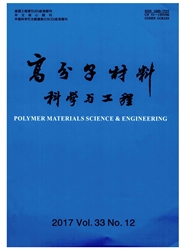

 中文摘要:
中文摘要:
采用傅立叶变换红外光谱(FFIR)分析了丁戊共聚物的微观结构,发现采用磷酸酯钕体系得到的丁戊共聚物组成不同,其聚丁二烯链节的顺式.1,4含量为93.1%~97.7%,聚异戊二烯链节的顺式-1,4含量为97.0%~97.5%。采用差示扫描量热仪(DSC)测试了丁戊共聚物的玻璃化转变温度,发现丁戊共聚物具有良好的耐低温性能,其玻璃化转变温度随着异戊二烯含量的增加而提高,稍偏离Fox方程,经修正得到的公式为Tg=1.03TglW1+TgBWb采用Kelen—Tudos法计算得到丁二烯和异戊二烯的竞聚率分别为1.21和0.73,二者乘积接近于1,表明丁戊共聚物为无规结构。利用碳核磁谱(13CNMR)对丁戊共聚物进行分析,对其二元序列进行了归属,计算得到丁戊共聚物的二元序列浓度以及聚丁二烯链节和聚异戊二烯链节的数均序列长度;采用Bernoullian模型和Markov模型验证了丁戊共聚物的序列分布,发现其序列分布更符合Markov模型,表明磷酸酯钕体系催化丁戊共聚合时,活性链有末端效应。
 英文摘要:
英文摘要:
Buiadiene and isoprene copolymerization were carried out at 50 °C in hexane for 8 h using Nd(P507 )3/A1H(i-Bu)JA1Et2C1 catalyst. The catalyst was aging at 60 ° for 2 h before initiation. FHR method was used to determine the microstructure of butadiene isoprene copolymer. The result showed the copolymer was of high cis-1, 4 content in both polybutadiene unit (cis-1, 4 = 93. 1% - 97. 7% ) and polyisoprene unit (cis-l, 4 = 97. 0% - 97. 5% ). DSC determination indicated that the copolymer was of excellent low temperature resistance. The butadiene-isoprene eopolymers showed only one glass transition temperature ( Ts ) from - 107. 2 °C to - 64. 4 °C, which increased with the increasement of the isoprene ratio. The correlation deviated from Fox equation, and could be modified as Ts = 1.03 Tst Wgl + TsB WB. The reactivity rate of the copolymer was calculated by Kelen - Tudos method. It turned out that the reactivity rates of butadiene(r1 ) and isoprene(r2 ) were 1.21 and 0. 73, respectively. The product of r1 and r2 was close to 1, which indicated the product is a random structure. The 13C NMR spectrum was used to determine the sequence distribution of the copolymer. The peak position in the aliphatic carbon part showed no difference while the composition changed in the copolymer. The compositions of 4 dyads of random butadiene-isoprene copolymers and the number average sequence length of polybutadiene and polyisoprene were calculated based on the peak area of 13C NMR spec-trum. The data were analyzed and examined in use of the statistical formula under Bernoullian model and Markov model. It turns out that all the data are more identical with Markov model than Bernoullian model. Moreover, the copolymer chains with higher Bd content contain longer polybutadiene segments, while the copolymer chains with higher Ip content contain longer polyisoprene segments.
 同期刊论文项目
同期刊论文项目
 同项目期刊论文
同项目期刊论文
 Synthesis and impact properties of in situ bulk made ABS resins toughened by high cis-1,4 polybuadie
Synthesis and impact properties of in situ bulk made ABS resins toughened by high cis-1,4 polybuadie 期刊信息
期刊信息
